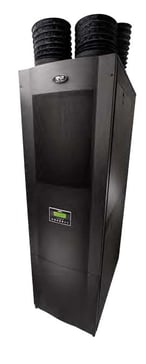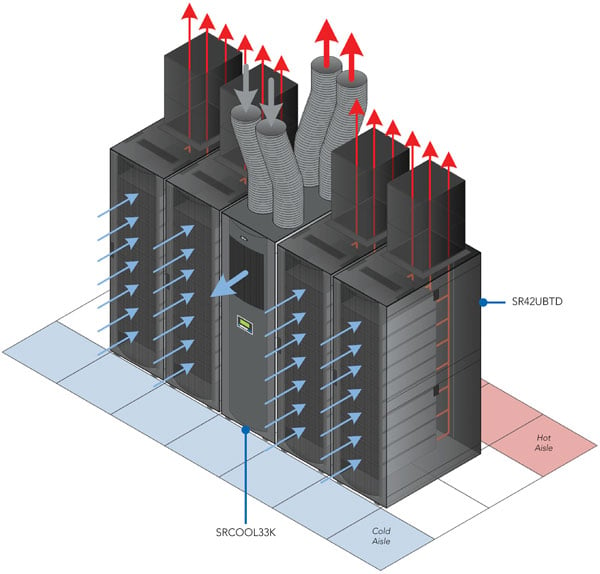 Data centers are often under pressure to not only lower energy costs, but to maximize performance and ensure the security of servers and network hardware. Most data centers use a majority of their energy on cooling and air handling, so increasing the efficiency of the cooling systems is pivotal in lowering energy costs. Tripp Lite has hundreds of vendor-neutral, EIA-compliant rack enclosures, open frame racks, wall-mount cabinets, self-contained cooling systems, and other solutions to help you save on energy expenses, while maximizing performance and increasing security.
Data centers are often under pressure to not only lower energy costs, but to maximize performance and ensure the security of servers and network hardware. Most data centers use a majority of their energy on cooling and air handling, so increasing the efficiency of the cooling systems is pivotal in lowering energy costs. Tripp Lite has hundreds of vendor-neutral, EIA-compliant rack enclosures, open frame racks, wall-mount cabinets, self-contained cooling systems, and other solutions to help you save on energy expenses, while maximizing performance and increasing security.
Tripp Lite Solutions Support Data Center Best Practices Including:
1. Implement Hot-Aisle/Cold-Aisle
Arrange racks in rows so the fronts face each other in cold aisles and the backs face each other in hot aisles. That prevents servers from drawing in hot air from servers in the adjacent row. According to studies by TDI Data Centers, hot-aisle/cold-aisle configurations can reduce energy use up to 20%. Tripp Lite's SmartRack enclosures (SR42UB and SR48UB) are optimized for hot-aisle/cold-aisle.
2. Install Blanking Panels
Blocking off unused rack spaces isn't just cosmetic, it forces cold air through your servers and prevents hot air from recirculating through the enclosure. Tripp Lite's 1U blanking panels (SR1UPANEL10 and SR1UPANEL50) snap into place without tools, saving significant installation time.
3. Organize Cables
Tangled cables can block airflow. In raised-floor environments, move cabling to overhead cable managers (SRCABLELADDER and SRCABLETRAY). Inside enclosures, use high-capacity cable managers (SRCABLEVRT3, SRCABLEDUCTVRT and SRCABLERINGVRT) to organize patch cables.
4. Replace Inefficient UPS Systems
Removing unnecessary heat sources helps cool the room. Replace traditional on-line UPS systems with energy-saving SmartOnline models to increase efficiency and reduce heat output, especially where redundant UPS systems operate below full capacity.
5. Use Close-Coupled Cooling
Gartner Group reports that close-coupled cooling increases efficiency compared to traditional perimeter and/or raised floor systems. "Close-coupled cooling allows you to focus cooling where it's needed most without lowering the temperature of the entire room," says Watkins. The modular nature of close-coupled cooling also allows data center managers to quickly reconfigure cooling to handle new equipment or overheating racks.
Tripp Lite's close-coupled cooling solutions are completely self-contained and can be installed by IT staff without costly contractors, plumbing, piping, special ductwork, floor drains, water tanks or extra parts. The portable SRCOOL12K provides 12,000 BTU (3.4 kW) capacity. The row-based SRCOOL33K has a standard 42U rack form factor, convenient L6-30P plug and provides 33,000 BTU (9.7 kW) capacity at costs up to 38% less per BTU than traditional designs. An innovative variable-speed, DC-inverter-driven compressor prevents disruptive inrush current, allows precise cooling adjustments and dynamically scales output to match the application, further reducing energy costs.

6. Isolate and Remove Hot Air
The SRTHERMDUCT kit can change a standard Tripp Lite SmartRack enclosure into sealed passive cooling structure that allows heat that is exhausted from equipment to be vented upwards into the facility CRAC/HVAC air return system. The adjustable roof-mounted thermal duct moves air upward and out of the rack enclosure.
For more information on Tripp Lite's Data Center Cooling Solutions or any other inquires, please contact your local Accu-Tech representative today!


.png?width=58&height=58&name=X_logo_2023_(white).png)
